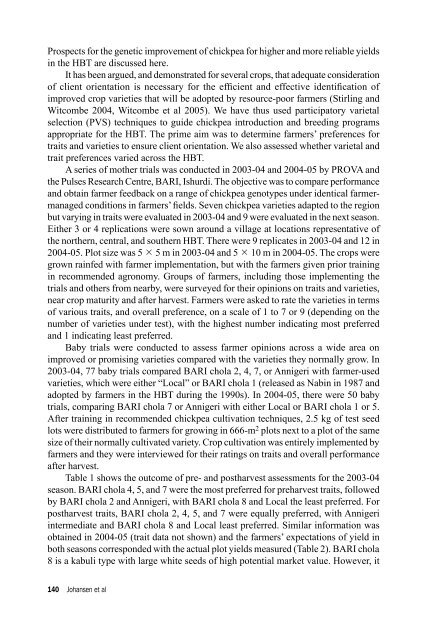Download (2461kB) - University of Greenwich
Download (2461kB) - University of Greenwich
Download (2461kB) - University of Greenwich
- No tags were found...
Create successful ePaper yourself
Turn your PDF publications into a flip-book with our unique Google optimized e-Paper software.
Prospects for the genetic improvement <strong>of</strong> chickpea for higher and more reliable yieldsin the HBT are discussed here.It has been argued, and demonstrated for several crops, that adequate consideration<strong>of</strong> client orientation is necessary for the efficient and effective identification <strong>of</strong>improved crop varieties that will be adopted by resource-poor farmers (Stirling andWitcombe 2004, Witcombe et al 2005). We have thus used participatory varietalselection (PVS) techniques to guide chickpea introduction and breeding programsappropriate for the HBT. The prime aim was to determine farmers’ preferences fortraits and varieties to ensure client orientation. We also assessed whether varietal andtrait preferences varied across the HBT.A series <strong>of</strong> mother trials was conducted in 2003-04 and 2004-05 by PROVA andthe Pulses Research Centre, BARI, Ishurdi. The objective was to compare performanceand obtain farmer feedback on a range <strong>of</strong> chickpea genotypes under identical farmermanagedconditions in farmers’ fields. Seven chickpea varieties adapted to the regionbut varying in traits were evaluated in 2003-04 and 9 were evaluated in the next season.Either 3 or 4 replications were sown around a village at locations representative <strong>of</strong>the northern, central, and southern HBT. There were 9 replicates in 2003-04 and 12 in2004-05. Plot size was 5 5 m in 2003-04 and 5 10 m in 2004-05. The crops weregrown rainfed with farmer implementation, but with the farmers given prior trainingin recommended agronomy. Groups <strong>of</strong> farmers, including those implementing thetrials and others from nearby, were surveyed for their opinions on traits and varieties,near crop maturity and after harvest. Farmers were asked to rate the varieties in terms<strong>of</strong> various traits, and overall preference, on a scale <strong>of</strong> 1 to 7 or 9 (depending on thenumber <strong>of</strong> varieties under test), with the highest number indicating most preferredand 1 indicating least preferred.Baby trials were conducted to assess farmer opinions across a wide area onimproved or promising varieties compared with the varieties they normally grow. In2003-04, 77 baby trials compared BARI chola 2, 4, 7, or Annigeri with farmer-usedvarieties, which were either “Local” or BARI chola 1 (released as Nabin in 1987 andadopted by farmers in the HBT during the 1990s). In 2004-05, there were 50 babytrials, comparing BARI chola 7 or Annigeri with either Local or BARI chola 1 or 5.After training in recommended chickpea cultivation techniques, 2.5 kg <strong>of</strong> test seedlots were distributed to farmers for growing in 666-m 2 plots next to a plot <strong>of</strong> the samesize <strong>of</strong> their normally cultivated variety. Crop cultivation was entirely implemented byfarmers and they were interviewed for their ratings on traits and overall performanceafter harvest.Table 1 shows the outcome <strong>of</strong> pre- and postharvest assessments for the 2003-04season. BARI chola 4, 5, and 7 were the most preferred for preharvest traits, followedby BARI chola 2 and Annigeri, with BARI chola 8 and Local the least preferred. Forpostharvest traits, BARI chola 2, 4, 5, and 7 were equally preferred, with Annigeriintermediate and BARI chola 8 and Local least preferred. Similar information wasobtained in 2004-05 (trait data not shown) and the farmers’ expectations <strong>of</strong> yield inboth seasons corresponded with the actual plot yields measured (Table 2). BARI chola8 is a kabuli type with large white seeds <strong>of</strong> high potential market value. However, it140 Johansen et al
















